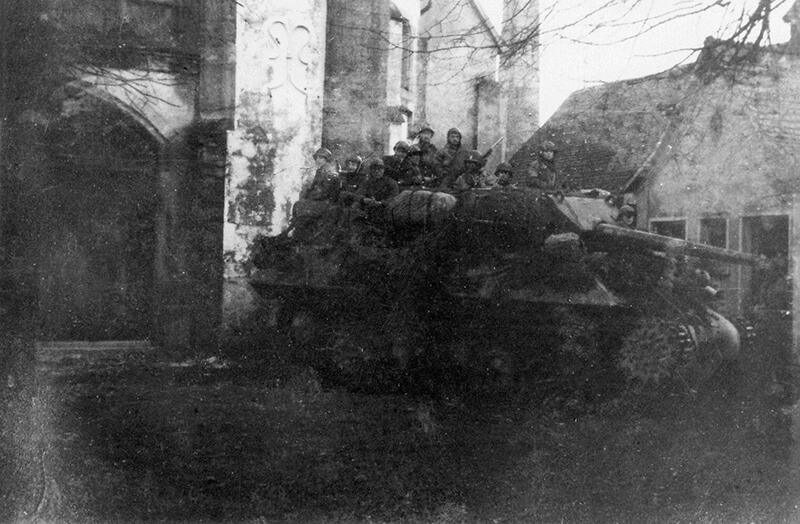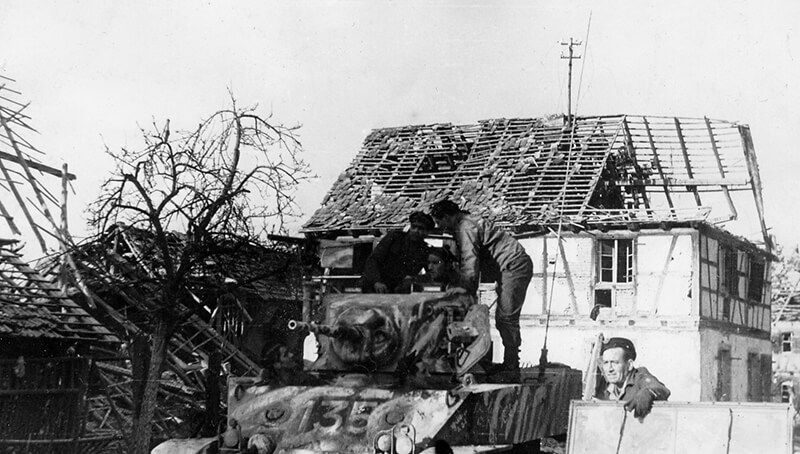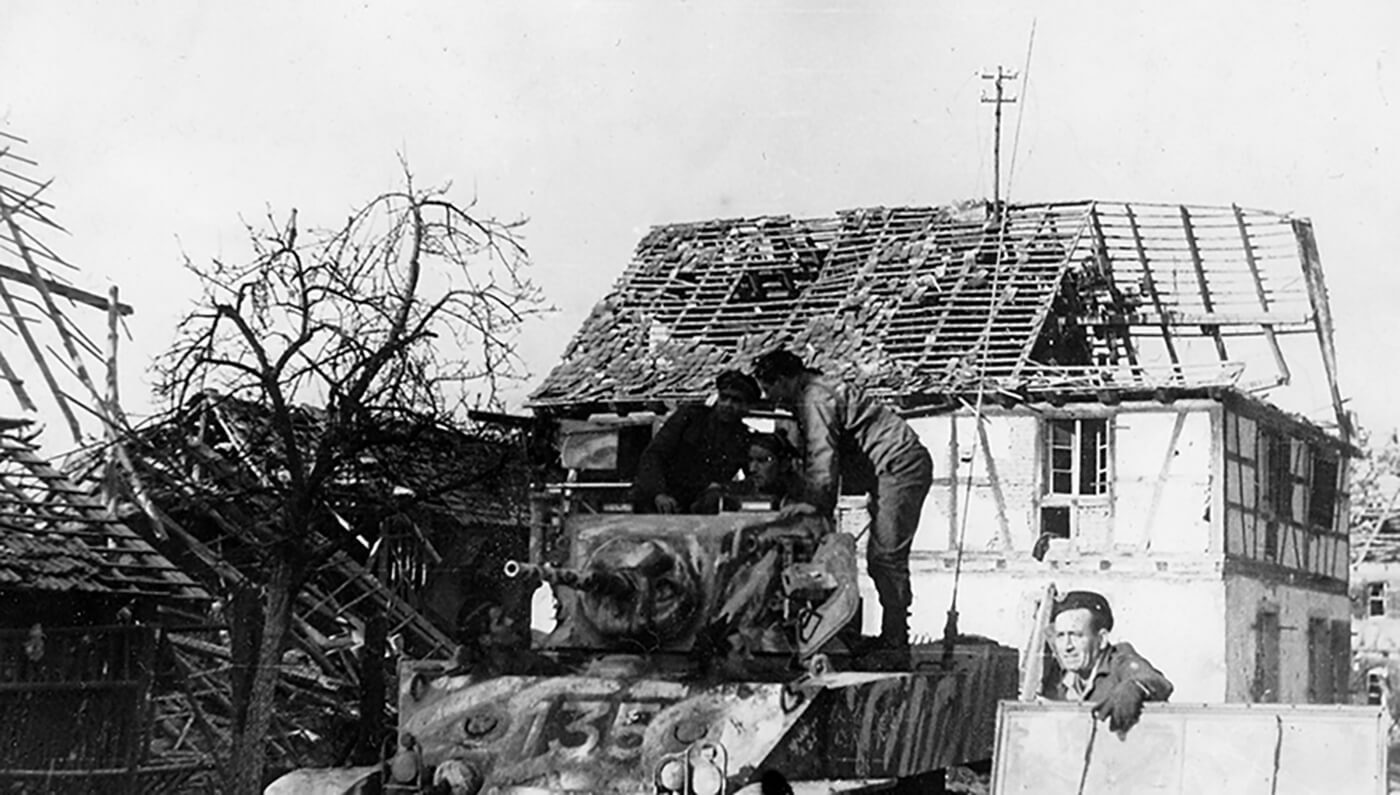| Page Created |
| February 23rd, 2024 |
| Last Updated |
| February 27th, 2024 |
| France |
 |
| Special Forces |
| 1er Bataillion de Choc Commandos de France Batallion Janson de Sally |
| Date |
| The Battle for Masevaux |
| Objectives |
- Capture the town of Masevaux
| Operational Area |
Masevaux, France
| Unit Force |
- Demi-Brigade de Choc of Lieutenant Colonel Gambiez.
- 1er Bataillion de Choc
- Commandos de France
- Batallion Janson de Sally
- 1er Division Française Libre
- 2e Bataillion, Légion Étrangère (Foreign Legion)
- 1er Régiment de Fusiliers Marins
| Opposing Forces |
- German Wehrmacht
| Operation |
| November 22nd, 1944 |
During the morning, the Batallion Janson de Sally boards the GMC’s Trucks and Dodge vans of the Train. After a stop in Sochaux, and passing through Lure and Giramagny.
The Demi-Brigade de Choc under Lieutenant-Colonel Gambiez is already in the operational area.
| November 23rd, 1944 |
Armoured units of the French 2nd Armoured Division enter Strasbourg.
| November 25th, 1944 |
Batallion Janson de Sally reaches Vescemant, on the edge of the Vosges, at 01:00 in the morning. Upon arriving at Vescemant, Lieutenant Colonel de Gayardon learns that his battalion is placed under the command of the Demi-Brigade de Choc of Lieutenant Colonel Gambiez. This Brigade includes the 1er Bataillion de Choc and the Commandos de France.” The Demi-Brigade is part of Groupe Simon under command of Captain Simon. Groupe Simon consists of the groupement du Corail, the Demi-Brigade de Choc, 2ème Bataillon de Légion Etrangère and one batterie du Régiment d’artillerie.
Later that day, the governor of Strasbourg, von Vatterodt, surrenders. General de Monsabert of the 2e Corps d’Armée promptly orders his Divisions to advance towards Masevaux and Thann. Groupe Simon moves towards Masevaux. In the south, in the Doller Valley, the Delange Brigade, reinforced by the 22e Bataillon Marche Nord Afrique, crosses the repairs bridges at Oberbruck, courtesy of the Engineers, and pushes towards Niederbruck, where the 3e Brigade de Légion Étrangère eventually captures the entire garrison.
During the day, the Battalion Janson de Sally sets off on foot towards Rougemont in the Vosges mountains. They pass through Grosmagny and Etueffont and reach the St. Nicholas convent, where nuns and girls distribute apples to them. Here they take a long pause in the snow without being able to rest to await a guide who, is coming from Masevaux and will lead them during the night, through mountain paths to Masevaux, crossing the German lines.
| November 26th, 1944 |
During the night, the situation is as follows. The Commandos de France have cleared part of the south zone of the city but only one commando has been able to cross the Daler river. This one is installed as a support point, in some houses, north of the river, in the rue de l’Eichbourg. However, the Germans have managed to isolate it. The commandos, who have suffered significant losses in the preceding days, cannot occupy the northern part of the city and seize the outlets of the Joffre road towards Thanen. This is the mission entrusted to the Bataillon Janson de Sailly. To fulfil it, they will have to cross the Doller, which is flooded.
The respective missions of the companies of the Bataillon Janson de Sailly are as followed. The 1er Compagnie and 3e Compagnie go on the attack at daybreak in a street fight. The 2e Compagnie and 4e Compagnie support them. Lieutenant Schoumacher, a solid Alsatian, a leader of men.
The 3e and 4e Compagnie take the following infiltration route in Masevaux: From Stoecken, the road goes down, and the companies enter Masevaux. They reach the Place des Allées where German minenwerfer attack them. Despite that they reach the town hall, then cross the half destroyed east bridge. An explosion has cut the deck flush with a pillar and the bridge collapsed, hitting the water’s edge. Crossing the axis of the bridge they are fired at with machine guns but are able to reach an intersection with a main street. The 4e Compagnie heads towards the western exits of the city to clear them. Here, Corporal Thorel and the Chasseur Bouillet are killed. Under mortar fire they reach the North West exit of Masevaux.
With the bulk of the 1er Compagnie being stuck in a dramatic situation, their mission is taken over by the 2e and 4e Compagnie. Only the Billecocq section (Compagnie) is able to continue with the 2e Compagnie.
From the church square, the 4e Compagnie advances directly towards its objective, along the street towards Niederbruck, Sewen, and the Ballon d’Alsace. Leading the way is the 2nd section, commanded by Aspirant Gérard. Elements of the 2nd Company, after crossing the Doller via the west bridge, progress along the same street. The interdiction fire is intense as the 2nd section reaches the last houses and advances in leaps towards the sawmill, about a hundred meters from the city exit and downhill from the road, behind the railway line.
The mortar fire intensifies, wounding Captains Juhel and Manil by the same shell. Taking command in the midst of the chaos, Lieutenant Schoumacher, leader of the 1st section of the 4e Compagnie, directs the company’s progression. The 2nd section of the 4e Compagnie continues to advance, managing to reach a building of the sawmill. However, its leader is incapacitated by a bullet to the thigh, leaving the section unable to proceed further, isolated after emerging from the city. Meanwhile, confusion reigns.
Responding to the situation, the battalion commander orders Lieutenant Schoumacher to hold a defensive position on the road to Sewen. He also instructs the bulk of the company to move towards the houses north of the railway line. Negotiating through alleys and dirt paths, the Billecag section (1er Compagnie) and the Tassin section (4e Compagnie) attempt to reach the railway line. Automatic gunfire, originating mainly from the Catholic circle located 150 meters east of the junction and fifty meters from the railway line, prevents any further advancement.
In response, Aspirant Billecag dispatches the 1st section (Le Coniac) with the mission to approach the Catholic circle from the south. Simultaneously, the 3rd section neutralizes it from the houses of the Flagellants’ ditch.
Despite the assistance provided by a heavy machine gun from the 1er Bataillon de Choc, the 1st and 4th sections are denied the city’s exit, and any action against the Catholic circle proves impossible. After reporting the situation, Lieutenant Schoumacher defensively positions the 4e Compagnie in the northern houses of the Flagellants’ ditch. The situation remains unchanged until nightfall; however, sporadic enemy fire continues, resulting in further casualties.
On the same day, Lieutenant Colonel de Gayardon is wounded (five shell fragments in the buttock), and Battalion Chief Berger takes command of the battalion.
| November 26th, 1944 |
Under the command of the 1st Brigade of the 22e Bataillon Marche Nord Afrique, the Battalion undertakes a forceful crossing of the Seebach at Oberbruck, followed by a determined and arduous advance across the eastern heights of Wegscheidt and Niederbruck.
Men from the 1er Régiment de Fusiliers Marins and the 8e Régiment de Chasseurs d’Afrique successfully seize control of Wegscheidt, Kirchberg, and Soultzbach in successive operations. Their progress is slow, taking three days to advance just 3 kilometres.
| November 27th, 1944 |
In Masevaux, the Germans intensify efforts to contain the Groupe Simon’s advance. The Brigade de Choc makes a daring attempt to cross the railway line at the town’s eastern exit. Despite facing heavy machine gun fire without artillery support, they are unable to penetrate the enemy’s defenses and suffer significant casualties. Consequently, the Groupe Simon, originally tasked with advancing towards Thann, shifts its focus to providing support in street-to-street combat, reverting from a pursuit group to a support group.
The 3e Compagnie of the 22e Bataillon Marche Nord Afrique initiates an operation to secure hill 647. Despite encountering stiff resistance halfway up the slope, the Rocques section manages to break through and reaches the cemetery and factory in Oberbruck. However, this success comes at a cost, with 2 soldiers killed and 4 wounded, all from the 4e Compagnie.
The Engineers work on repairing the bridge breach, but an 88 millimeter shell hits the pontoon section and the bulldozer. They halt their work and the bulk of the armoured group moves to another axis and secures possession of Masevaux. The Germans put heavy artillery fire on Kirchberg where the troops converge.
| November 28th, 1944 |
Seeing that Goupe Simon is unable to advance on the planned axis, General de Monsabert places it under the command of the 2e Division d’Infanterie Marocaine (2e DIM) and directs its efforts towards Lauw, a key position fiercely defended by the Germans to prevent the encirclement of their troops in the Belfort pocket.
The night passes without any notable incident. A patrol of the the Bataillon Jason de Sally led by Chief Warrant Officer Menin and Sergeant Masso capture a prisoner and the assessment of some of the enemy’s forces. They observe around fifty Germans at the Catholic circle. At 05:30, the company evacuates its positions and the preparatory fire begins.
The 2e and 4e Squadrons of the Régiment de Fusiliers Marins, accompanied by the 11e Cuirassiers and the 8ème Régiment de Chasseurs d’Afrique, join the Demi-Brigade de Choc in clearing the northern part of the city. Entrenched in the castle and the chapel, the Germans put up fierce resistance.
At 06:30, elements of the 1er Bataillon de Choc, and then tanks, engage enemy positions. There is retaliation from a German anti-tank gun firing from the Bourbach road. The sector occupied by the 2nd section of the 4e Compagnie is heavily shaken. A skirmish erupts around the sawmill along the Cernay-Sewen railway line. Well-armed and led by resolute individuals, the Germans unleashed bursts of fire from light machine guns, MP40s, MP43s, and Mauser rifles against the Cuirassiers. They also employ Panzerfaust direct-fire rockets, causing significant damage to roads, walls, and buildings.
Assistance arrives in the form of tanks from the Régiment de Fusiliers Marins, including two tanks from the 1e Squadron commanded by Lieutenant Roger Barberot. The response is swift and effective. While using 37 millimeter cannons and heavy machine guns mounted on the armoured vehicles, and various other weapons, they subdue the enemy. From here the progress of the attack goes fast, they occupy the sawmill, then the farm and the villa it overlooks. Several Germans are killed or wounded in the exchange. Following this intense encounter, the remaining Germans, surrender. Allowing, the occupation of the castle, and the Catholic circle with the collaboration of the 1st and 2nd sections of the 4e Compagnie. The nearby streets are littered with the bodies of the fallen. The French take many prisoners, some of whom are injured.
Later in the morning, the 2e Bataillion of the Légion Étrangère (Foreign Legion) belonging to the 1er Division Française Libre arrives. Commandos and legionnaires advance towards Bourbach. The Germans seems to have withdrawn from the outskirts of Masevaux, and there is no knowledge if fighting that took place north of the valley. Later in the day, various support vehicles and enemy combat trains engage on the road. Masevaux is liberated.
The Groupe Simon attacks along the road from Masevaux to Lauw to support the breakthrough of the 4e Régiment de Tirailleurs Marocains. The sub-group led by Commander Fourlinnie, advancing along the Doller from Masevaux. It reaches the outskirts of Niederbruck and makes contact with the 22e Bataillon Marche Nord Afrique.
| November 29th,1944 |
Complete capture of Kirchberg and Langendfeld, then Niederbruck by the 22e Bataillon Marche Nord Afrique. Liaison with the 3e Bataillion of the Légion Étrangère. The troops create an effective junction with Masevaux. The 3rd Company of the 22e Bataillon Marche Nord Afrique sends a patrol to the Entzenberg.
| Aftermath |
Twenty-seven men of the Batallion Janson de Sally lose their lives on the banks of the Doller. General de Lattre reports the total toll of 45 dead and many wounded who did not survive their injuries.
| Multimedia |

Gérard Galland 11e Cuirassiers


